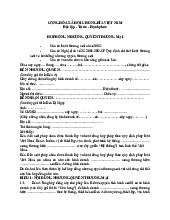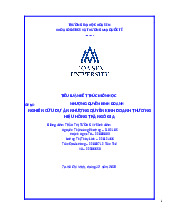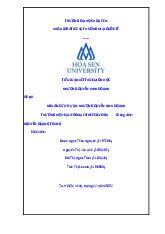






Preview text:
lOMoAR cPSD| 47206417
Activity 2: Coupling Analysis Challenge (15 minutes) Scenario: You are
consulting for a manufacturing company deciding between two supply chain strategies.
Strategy A: Just-in-Time (Close-Coupled)
Parts arrive exactly when needed Minimal inventory storage
Direct integration with supplier systems Lower storage costs
Strategy B: Traditional Inventory (Loosely-Coupled) 2-week inventory buffer maintained Less supplier integration Higher storage costs More autonomy Group Task:
1. List 3 advantages and 3 disadvantages for EACH strategy
Strategy A: Just-in-Time (Close-Coupled) Advantages:
1. Reduces inventory holding costs significantly.
2. Improves cash flow and efficiency by minimizing waste.
3. Promotes strong coordination and data sharing with suppliers, leading to faster response times. Disadvantages:
1. Highly dependent on supplier reliability and transport accuracy — any delay can stop production. lOMoAR cPSD| 47206417
2. Vulnerable to supply chain disruptions (e.g., natural disasters, pandemics).
3. Requires advanced BIS and continuous monitoring, which can be costly to implement.
Strategy B: Traditional Inventory (Loosely-Coupled) Advantages:
1. Provides greater flexibility and independence from suppliers.
2. Reduces the risk of production stoppages due to delays in supply.
3. Easier to manage for companies with limited IT integration. Disadvantages:
1. Higher inventory and storage costs.
2. Risk of overstocking or obsolescence if demand changes.
3. Slower response to market or production fluctuations.
2. Under what business conditions would you choose Strategy A?
Business Conditions to Choose Strategy A (Just-in-Time)
You should choose Strategy A when: •
Demand is stable and predictable. •
Suppliers are reliable and located nearby. •
Transportation systems are efficient and consistent. •
The company has strong BIS (e.g., ERP, SCM systems) that allow realtime coordination and forecasting. •
The goal is to minimize cost and increase efficiency in a stable environment.
Điều kiện kinh doanh phù hợp để chọn Chiến lược A (Just-in-Time) lOMoAR cPSD| 47206417
Nên chọn Chiến lược A khi: •
Nhu cầu thị trường ổn định và có thể dự báo chính xác. •
Nhà cung cấp đáng tin cậy, vị trí gần cơ sở sản xuất. •
Hệ thống vận tải hiệu quả và ít rủi ro. •
Doanh nghiệp sở hữu hệ thống thông tin mạnh (ERP, SCM, EDI, IoT), có
thể đồng bộ dữ liệu theo thời gian thực. •
Mục tiêu là tối thiểu hóa chi phí và tối đa hóa hiệu quả vận hành trong môi trường ổn định.
3. Under what business conditions would you choose Strategy B?
Business Conditions to Choose Strategy B (Traditional Inventory) You
should choose Strategy B when: •
The supply chain environment is uncertain or volatile. •
Suppliers are far away or prone to delivery delays. •
Demand is fluctuating or difficult to predict. •
The company prefers autonomy and less dependency on external partners. •
There is limited IT integration or low data sharing capacity.
4. What role do BIS play in making each strategy work? Real-World
Connection: Discuss what happened during COVID-19 pandemic - which
companies survived better?
Role of BIS (Business Information Systems)
BIS are essential to make both strategies work effectively: • For Strategy A (JIT): lOMoAR cPSD| 47206417
o Enables real-time communication and data exchange between company and suppliers.
o Tracks inventory levels, demand forecasts, and shipment schedules automatically.
o Helps prevent stockouts and synchronize production precisely. •
For Strategy B (Traditional):
o Helps optimize inventory levels and warehouse operations.
o Provides demand trend analysis and reorder alerts. o Supports better
planning for buffer stock and cost control.
Real-World Connection – COVID-19 Pandemic
During the COVID-19 pandemic, global supply chains were heavily disrupted
due to lockdowns and transport restrictions. •
Companies using Just-in-Time (close-coupled) strategies — such as Toyota
or Apple — suffered from part shortages and production delays because of
their reliance on timely supplier deliveries. •
Meanwhile, companies with traditional or loosely-coupled inventory
systems, such as Samsung or Unilever, performed better since their buffer
stocks allowed continued operations even when supply routes were blocked. ✅ Conclusion:
In stable times, JIT is more efficient and cost-effective.
In uncertain or high-risk environments, maintaining buffer inventory provides better resilience and continuity.
Case Scenario: Three Coffee Shop Strategies You are analyzing three coffee
shops in the same neighborhood: lOMoAR cPSD| 47206417
Coffee Shop A: "Quick Bean" Mobile app for pre-ordering Automated espresso
machines Self-service pickup Lowest prices in area Limited seating Focus: Speed and cost
Coffee Shop B: "Artisan Brew" Hand-crafted beverages Unique specialty drinks
Instagram-worthy presentations Premium beans from specific farms Higher prices Focus: Quality and uniqueness
Coffee Shop C: "Tech Café" AR menu showing drinks in 3D Blockchain-based
loyalty program AI barista recommendations Cryptocurrency payment accepted
Drone delivery testing Focus: Innovation and experience Group Tasks:
1. Identify which of Porter's three competitive strategies each shop uses
Xác định chiến lược cạnh tranh (Porter’s Three Competitive Strategies) của từng quán
Theo mô hình của Michael Porter, có 3 chiến lược cạnh tranh chính: •
Cost Leadership (Dẫn đầu chi phí) •
Differentiation (Khác biệt hóa) •
Focus (Tập trung vào phân khúc cụ thể)
Chiến lược cạnh tranh Quán Giải thích chính
Giảm giá tối đa, tự động hóa và phục vụ Quick Cost Leadership (Dẫn
nhanh để tiết kiệm chi phí, thu hút khách Bean đầu chi phí)
hàng nhạy cảm với giá.
Tạo sự khác biệt qua chất lượng, nguyên
Artisan Differentiation (Khác
liệu cao cấp và phong cách phục vụ nghệ Brew biệt hóa) thuật. lOMoAR cPSD| 47206417 Focus Differentiation
Hướng đến nhóm khách hàng yêu công Tech
(Khác biệt hóa tập
nghệ, tìm kiếm trải nghiệm mới, sử dụng Café trung)
công nghệ tiên tiến để tạo lợi thế cạnh tranh.
2. What BIS does each shop need to support their strategy?
Mỗi quán cần hệ thống thông tin doanh nghiệp (BIS) nào để hỗ trợ chiến lược của mình? Quán
Hệ thống thông tin cần thiết (BIS) Mục đích -
Ứng dụng di động đặt hàng trước Quick
Giúp đặt hàng nhanh, giảm chi phí nhân sự, - Hệ thống POS tự động Bean
tối ưu hóa quy trình phục vụ. -
Phân tích dữ liệu bán hàng theo thời gian thực -
CRM (Quản lý quan hệ khách hàng) -
Hệ thống quản lý nguồn cung Giúp cá nhân hóa trải nghiệm, quảng bá
Artisan ứng (SRM) để theo dõi chất lượng hạt thương hiệu cao cấp, duy trì chất lượng và Brew cà phê
mối quan hệ với nhà cung cấp. -
Phân tích mạng xã hội (Social Media Analytics)
- Hệ thống AR & AI Recommendation Engine
Tăng trải nghiệm khách hàng, nâng cao tính
Tech Café - Blockchain loyalty program
tương tác và hiện đại hóa thương hiệu.
- Nền tảng thanh toán điện tử tích hợp
3. Analyze using value chain - where does each add value? Hoạt động chính (Primary Activities) Quick Bean Artisan Brew Tech Café
Inbound Logistics(Nhập Mua hàng với giá Lựa chọn nhà cung cấp Tối ưu chuỗi cung ứng qua nguyên liệu)
thấp, tiêu chuẩn đặc sản, nguyên liệu dữ liệu và công nghệ Hoạt động chính (Primary Activities) Quick Bean Artisan Brew Tech Café hóa cao cấp
Pha chế thủ công, đảm Tích hợp AI, AR, và robot
Operations (Vận hành) Tự động hóa, quy trình nhanh bảo chất lượng phục vụ lOMoAR cPSD| 47206417
Ứng dụng di động, Định vị thương hiệu Marketing trải nghiệm Marketing & Sales khuyến mãi giá
cao cấp, hình ảnh đẹp công nghệ thấp Tương tác thông minh,
Service (Dịch vụ hậu Nhanh gọn, tiện Trải nghiệm cá nhân chăm sóc qua dữ liệu mãi) lợi hóa, dịch vụ tận tâm khách hàng
4. Which strategy would YOU invest in? Why?
👉 Lựa chọn đề xuất: Tech Café Lý do: •
Phù hợp xu hướng công nghệ và trải nghiệm cá nhân hóa trong ngành F&B hiện nay. •
Có tiềm năng mở rộng và tạo lợi thế cạnh tranh dài hạn thông qua đổi mới số. •
Mô hình có thể kết hợp công nghệ và dịch vụ cao cấp để thu hút giới trẻ, dân văn phòng
và khách hàng yêu công nghệ.
5. How could each use BIS to strengthen their competitive
advantage?Extension: What if Amazon opens "Amazon Café" - how should each respond? Quán
Cách sử dụng BIS để củng cố lợi thế
Quick Bean Dùng dữ liệu từ ứng dụng để dự báo giờ cao điểm, tối ưu nhân lực và tồn kho. Artisan Brew
Phân tích dữ liệu khách hàng để cá nhân hóa menu, tăng trải nghiệm sang trọng.
Tech Café Dùng AI học thói quen khách hàng, AR tạo tương tác, blockchain tạo lòng trung thành bền vững.




